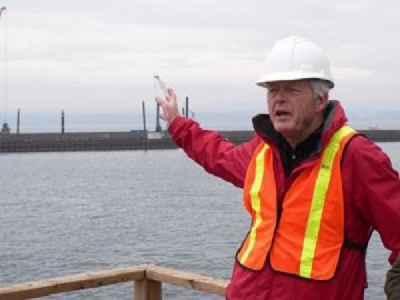
Posted on November 21, 2016
By Kevin Werner, Hamilton Community News
There is an emerging six-hectare, nearly $140-million structure growing on the toxic hot spot known as Randle Reef, near Pier 15 that will become a permanent fixture on Hamilton’s port lands.
Since the spring construction has been underway on stage one of building the $138.9 million engineered containment facility (ECF) that will house the final resting place of 695,000 cubic metres of polycyclic aromatic hydrocarbons. The toxic sediment is a byproduct of more than 100 years of burning coal and industrial dumping.
“It’s big, it’s really big,” said Jon Gee, manager of the Great Lakes’ Area of Concern section for the federal Environment and Climate Change.
The federal government allowed a group of reporters to view the construction so far from Pier 15 on an overcast Nov. 16 morning.
Gee said if the 3,000 steel pilings that form the inner and outer walls, which range in size from 60 feet to 101 feet, were laid end to end, you would have a “ribbon of steel” stretching from Hamilton to Niagara Falls.
The steel used for the containment facility was produced by Nanticoke’s U.S. Steel Canada facility.
The ECF is a double-walled structure, with a 15-metre outer wall and inner wall, which is an environmental barrier.
Randle Reef, considered the largest toxic coal-tar deposit in Canada, is about 60 hectares in size (120 football fields). The ECF, which will be six hectares or 14 acres in size, will be located on top of the most contaminated site. The ECF is scheduled to be completed by the fall of 2017. Starting 2018 the area will be dredged of contaminated sediments and dumped into the ECF. Capping the ECF will take three year starting in 2020, with an expected end date of 2022.
“We are on time and on budget,” said Gee.
Once the facility is completed, the Hamilton Port Authority will take it over, operating it as a marine terminal, generating revenues in order to maintain it, said Gee.
He said the surrounding area where the toxic sediments were dredged will be capped allowing the marine life to migrate back into the area. The contaminated soil will be sucked up using hydraulic dredging.
The 15-metre space between the inner wall and exterior wall will be dredged and backfilled with uncontaminated material.
“Everything will become a more natural state,” said Gee. “When it’s cleaned up it will contribute to the delisting of Hamilton Harbour. The fish population is already coming back.”
Building the ECF, essentially a box, in order to “contain and cap” was the preferred option of a Project Study Group in 2002.
“It is probably the most economically,” said Gee.
The federal and provincial governments contributed $43.3 million each, while Hamilton, Burlington, Halton Region, the Hamilton Port Authority and U.S. Steel contributed the remaining one-third of the cost.
Hamilton Harbour is one of the 17 Great Lakes’ Areas of Concern in Canada. There are a total of 43 AOCs in both Canada and the United States. One of the reasons for the harbour, which was identified as an AOC in 1985, to be kept on the list for so long was because of Randle Reef’s contaminated materials.
Canada has delisted three Canadian sites, while there have been four United States locations that have been delisted.
Officials said the stage one work, which began in the spring, will cease by mid-December. It will start up again in early 2017 and the tender for the stage 2 work will be issued.
Source: Hamilton Community News





